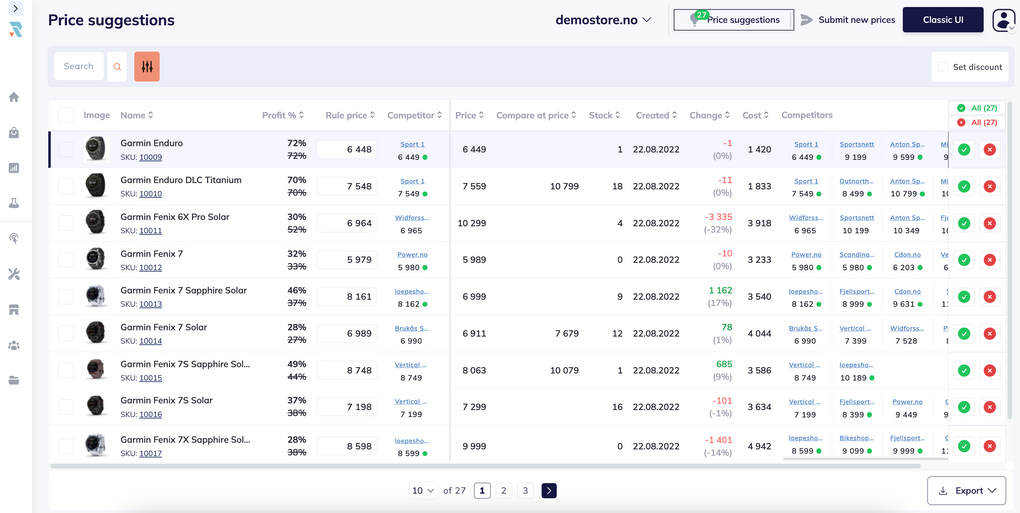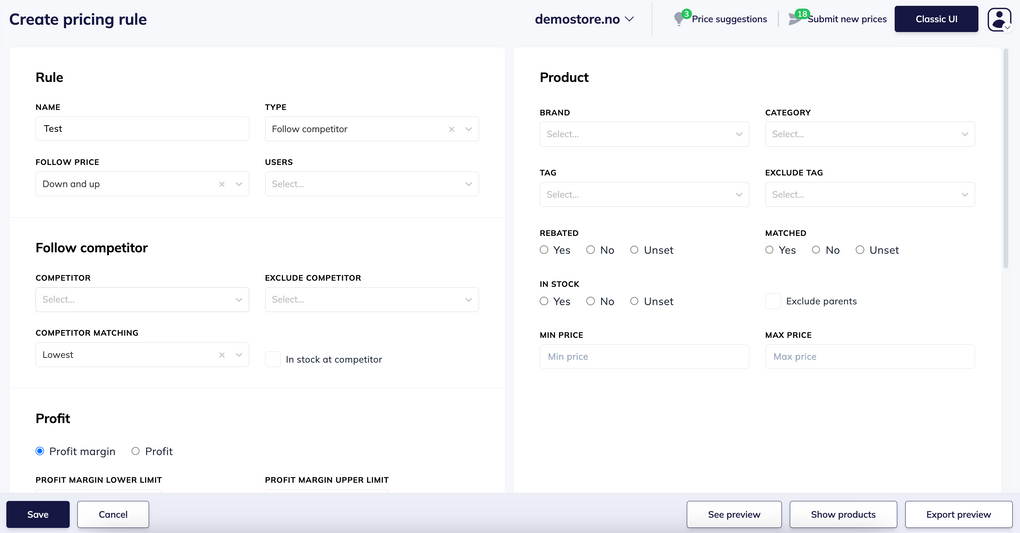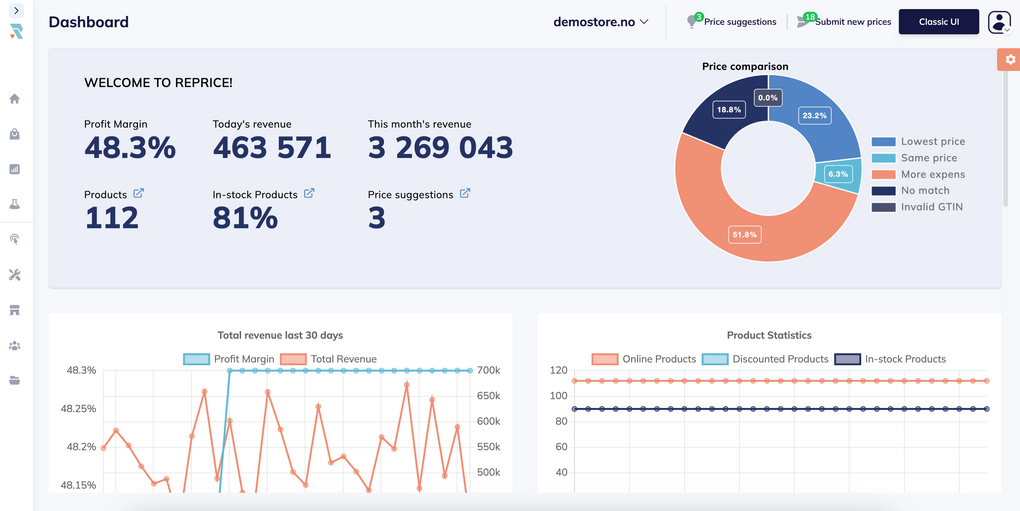How To Boost Profits In Niche E-commerce With Smart Pricing Strategies
March 05, 2024 | 10 minutes read
Navigating the niche e-commerce landscape requires more than just a great product; it demands smart pricing strategies.
In a terrain where every customer counts and competition is nuanced, setting the right price isn't just beneficial—it's essential. That’s why in this article, we’ll explore how tailored pricing can be your most powerful tool.
We'll uncover how effective pricing not only captures the unique dynamics of your market but also significantly amplifies your profitability.
Plus, how pricing optimization software and tools can help you tailor your strategy to match the ever-changing demands and preferences of your target market.
In this article:
- 3 characteristics of niche markets and their impact on pricing strategies
- Challenges in pricing for niche e-commerce
- Leveraging pricing tools for strategic pricing in niche markets
- Conclusion
3 characteristics of niche markets and their impact on pricing strategies
A niche market serves a specific, targeted audience within a larger market, addressing their unique needs and interests. It's specialized, not general.
Some key features of niche markets include:
- Fewer rivals: In niche markets, there's less competition. Take an artisanal coffee shop in a small town as an example. It stands out by offering a unique experience and builds a stronger bond with its customers, something not readily available elsewhere.
- Targeted customers: In niche markets, shoppers are searching for particular products. These aren't just any buyers; they're potential loyalists who, if they connect with your product or service, are likely to stay devoted.
- Unique products or services: From bespoke jewelry to cutting-edge tech gadgets, niche markets are all about unique products or services. This distinctiveness not only helps businesses stand apart but also often allows for premium pricing.
Niche e-commerce’s impact on pricing strategies
In niche e-commerce, pricing is a key strategic element shaped by the unique features of your market.
With fewer competitors, you gain greater leeway in setting prices. There's no constant need to align with or undercut a host of rivals. This flexibility allows you to explore various pricing options to discover the sweet spot for both your business and your customers.
So for example, adopting value-based pricing can transform how you approach your specialized customers.
Consider an example of selling high-end, organic coffee beans.
To set the scene: The coffee industry itself presents a lucrative opportunity for investors and entrepreneurs alike. As of 2019, the global coffee market boasted a remarkable valuation of around $102.15 billion. Forecasts suggest that by 2026, the market is poised to generate revenues of approximately $155.64 billion.
To an aficionado, a true coffee-enthusiast, these coffee beans are much more than just a drink; they're an entire experience. This perspective allows you to set your prices based on the value your product brings, rather than simply its cost.
By highlighting what makes your products special, you can justify premium pricing. Whether it's through unmatched craftsmanship, the latest technology, or unique features, your product stands out and deserves a higher price.
Customers looking for these one-of-a-kind items recognize their value and are often ready to pay more for products that meet their specific needs or aspirations.
So, to sum up: Niche e-commerce offers the opportunity to craft a pricing strategy that goes beyond just price competition. It's about leveraging the distinct value that your business brings.
Challenges in pricing for niche e-commerce
Setting the right prices in niche e-commerce isn't straightforward. You've got to nail that perfect price and really understand your market and competitors.
Let's break down these two challenges and discuss what's key:
1. Figuring out the best price point
It's all about balancing making a profit and what your customers think is fair value. In a niche market, where getting the price right is crucial.
Price it too high, and you might scare off your customers; too low, and your product might seem less valuable.
Plus, understanding what your customers are willing to pay is key.
This means diving deep into market research, which can be tough in niche markets where customers have varied expectations. You'll need to focus on specific surveys and analyze customer feedback to get it right.
2. Tackling competition and market analysis
Looking at the limited competition in niche markets, you'll find that the handful of competitors often differ a lot in what they offer and their prices. Keeping an eye on them requires a more tailored approach than in bigger markets.
Plus: Keeping up with market trends and what customers want in niche markets is crucial, as these can change quickly.
You've got to stay on top of research and be ready to adapt. This keeps your pricing strategy on point and relevant.
So in a nutshell, pricing in niche e-commerce is all about striking a strategic balance.
You've got to really get your unique market, know what your customers prefer, and keep an eye on your competition. It's about crafting a pricing strategy that hits your business targets and genuinely clicks with your customers.
Leveraging pricing tools for strategic pricing in niche markets
To handle the complexities of pricing in niche markets, using tools like Reprice is key.
Why? Because tools like that are built to get your pricing strategy in sync with market changes and what your competitors are doing:
1. Analyzing market demand
Here's how Reprice tools help you stay on top of and react to market demand.
- Automated and data-driven pricing: Reprice lets you set up automated pricing rules based on things like brand, category, or tags. This helps you react just right to market demand.
You can tailor these rules to keep up with market trends or what your competitors are doing, making sure your prices are always competitive and on point.
- Daily price recommendations: Every day, Reprice checks out market trends and gives you pricing suggestions. You need to approve or nix these before they go live.
This feature helps make sure your pricing takes advantage of the current market demand, especially for items with big margins or lots of demand.

- Bulk pricing updates: Got new retail prices from your suppliers? Reprice can update prices in bulk for whole categories, brands, or tags.
This is important for those quick responses to market changes, like when new products hit the scene or during seasonal shifts (like "new-year-new-me" or summer sales).

2. Gleaning insights into competitor pricing
Using Reprice gives you a deep dive into how your competitors handle pricing. Here’s how:
- Real-time competitor data: With Reprice, you get live updates on what your competitors are up to with their pricing. This means you can ditch manual tracking methods like Excel. It gives you a fresh, dynamic look at the market, helping you tweak your pricing strategies on the fly.
- Comprehensive market overview: The tool gives you a bird's-eye view of the whole market. You'll be able to spot new competitors and adjust your prices accordingly. Plus, its integration with your core business systems means you've always got the latest info to make smart decisions.
For instance, imagine you're running an online boutique for eco-friendly apparel.
With Reprice, you can instantly see if a competitor starts offering a similar range of organic cotton t-shirts at a lower price, allowing you to adjust your pricing or promotional strategies in real-time to stay competitive.
The result?
You're always a step ahead, maintaining a competitive edge in your niche market. Your boutique remains relevant and appealing to your eco-conscious customers, ensuring that your brand not only survives but thrives amidst evolving market conditions.

3. Helping you implement a dynamic pricing strategy
Dynamic pricing can be a game changer in niche markets. Here’s how Reprice makes real-time price adjustments easy for maximizing profits:
- Manual price control: Reprice gives you the power to change prices manually for specific products, brands, or categories.
This comes in handy for unique situations like seasonal trends, special promotions, or when you need a specific pricing approach. It lets you quickly adapt to what's happening in the market.
- Smart automated pricing: Switch to a forward-thinking pricing strategy with Reprice's automated optimization.
This feature boosts your revenue and margins by allowing fast price adjustments based on set rules, like keeping a minimum margin or responding to competitors' prices.
- Consistent pricing across channels: Reprice works with different e-commerce platforms and ERP systems, making sure your prices are the same everywhere. This is crucial for keeping your pricing straight and cuts down the need for moving data around manually.
- Streamlining product feeds: With Reprice, managing product feeds for platforms like Google Merchant Center is a breeze.
This helps optimize your ad campaigns by focusing your budget on products that give the best return on investment. It makes sure your online ads are efficient and your products are priced just right in the market.

Conclusion
As we've explored, understanding your unique market, aligning with customer preferences, and staying ahead of competition are key.
Tools like Reprice play a crucial role, offering automated, real-time solutions for dynamic pricing and market adaptation.
So whether it's responding swiftly to market demand, gaining insights into competitor pricing, or managing product feeds efficiently, Reprice ensures your pricing strategy is as dynamic and unique as your niche market.
Embrace these strategies, and watch your niche e-commerce venture not just survive but thrive, securing both customer satisfaction and business profitability.
Ready to get started with Reprice? Book a demo here.
Robin Frugaard Jørgensen
Chief Commercial Officer at Reprice
Robin Frugaard Jørgensen is Chief Commercial Officer at Reprice. Prior to joining Reprice in January 2023, Robin spent several years working with pricing strategies in B2B & the consumer electronics industry. Connect with Robin on LinkedIn here or book a demo to see how Reprice can solve your e-commerce pricing challenges.
